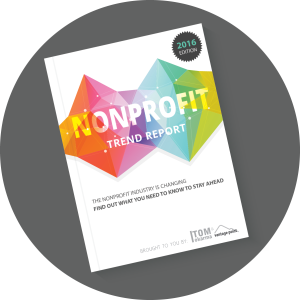7 Ways To Help Reduce Nonprofit Employee Turnover
In compiling the 2016 Nonprofit Trends Report, we discovered hiring at US nonprofits is at an all time high. Great news for all those needing a job with more purpose. But our data uncovered another trend and it’s something you just can’t ignore. Employee turnover in this same sector is at 20% and climbing. That means 2 out of 10 of your staff may leave before the end of the year. For some agencies, this number may be even higher. How would this effect your organization?
Instead of celebrating the expansion of nonprofit influence and impact across the nation, we are actually seeing agencies burdened by the constant need to recruit, hire, train, and then replace staff and key volunteers. And this doesn’t even take into consideration the impact on client services when you have unfilled positions. Remember how much “fun” it was the last time you had a key spot to fill on your team?
While a little employee turnover every year is acceptable and even healthy for an organization, if you are seeing 15% or more year after year, something is wrong. According to a survey by Nonprofit HR in 2015, nonprofit turnover increased from 16% in 2013 to 19% in 2014. According to projections, this number will only continue to increase.
Staff and key volunteer turnover is the highest non-cash expense any organization incurs.
Regardless of whether the person turns out to be a poor fit for your agency and is released, or they simply leave for a better opportunity, this costs you a significant amount of time and money…and leaves a lasting impact on your agency.
Take a minute and count the hours it took you to identify, recruit, train, and deploy a recent hire. Now, multiply that number by your average hourly compensation factor representing the average salary costs to the agency. That’s some number, isn’t it?
Now, multiply that cost by the number of new hires last year. Pretty shocking isn’t it? This number doesn’t take into account the non-cash disruption to your operation — as a result of being short of staff while recruiting a replacement — or the disruption as the new hire learns your operations.
With nonprofit revenues under extreme pressure and with more clients than ever seeking your services, you have to do something to address this huge problem. What you can do to cut down on costly key volunteer and staff turnover?
7 Ways to Reduce Employee Turnover
- Realize you need to motivate nonprofit staff and volunteers differently than most business people. For them, it’s not about the money or prestige. They want to feel they are making a difference. Tthey have a passion for your mission and want to help you achieve it. Are you giving them ample opportunity to do meaningful work that addresses that passion?
- Acknowledge the gap between for-profit and nonprofit pay scales. Since compensation in nonprofits is usually lower than in the business world, what can you do to negate that compensation gap stigma? Can you provide personal and professional development opportunities for key staff and volunteers? This might help them value their participation in your agency more widely than just by compensation. Training, conferences, workshops, and individual personal growth coaching can help people feel they are being adequately compensated above and beyond salary, etc.
- Fine-tune your hiring process and focus on high-quality candidates. Are you being selective in the hiring process or are you just looking for warm bodies to fill open slots? In addition to your stated Mission and Vision, do you look for candidates who agree with your agency’s values? A bad match here can be as harmful and as anything else. Review your hiring practices to insure you are screening out applicants who do not match the job description and its “Desirable Qualifications”.
- Get feedback from those that leave before they leave. Do you (or someone else in your organization) conduct exit interviews with departing staff and volunteers to learn why they decided to leave? If so, do any patterns emerge? Compensation levels, poor working conditions, excessive workload, safety issues, lack of respect, etc. can all lead to an employee leaving. If you see reasons repeated among individuals, how can you address these patterns? If you’re not conducting exit interviews, could you start to collect feedback from employees who are leaving?
- Create better job descriptions. Do your job descriptions accurately describe the duties the applicant is expected to perform? And beyond the actual job requirements, do you paint a picture of the culture of your nonprofit? Do you make it clear the type of individual that would fit well into your organization? What characteristics would best fit your agency?
- Get feedback after they leave. Consider contacting former staffers 6 months after they leave to get feedback. Ask them how to make serving at your agency more appealing and how to reduce turnover. They may have some great ideas and will feel more comfortable to speak freely now that they have moved on.
- Build a team and process for vetting. Rather than conducting just 1-2 interviews with new hire or volunteer candidates, consider using a multi-interview process for applicants. Consider having 2-3 staff members interview an applicant separately. Then, have a panel interview with 2-4 other people. This may be overkill for some positions, but for filling key positions in your agency, it is well worth your efforts.
Excessive turnover is often linked to a weak or ineffective hiring process. While other factors may play a role, focusing your efforts first on this area will likely lead to the most significant change in the least amount of time.
Employee turnover can cripple an organization — both nonprofit and for-profit. Your employees — and volunteers — are the lifeblood of an agency. If you’re experiencing higher-than-normal turnover, it’s likely that your clients — and those your serve — are feeling the impact as well.
To learn more about key challenges facing the nonprofit industry, download your copy of the 2016 Nonprofit Trends Report.


